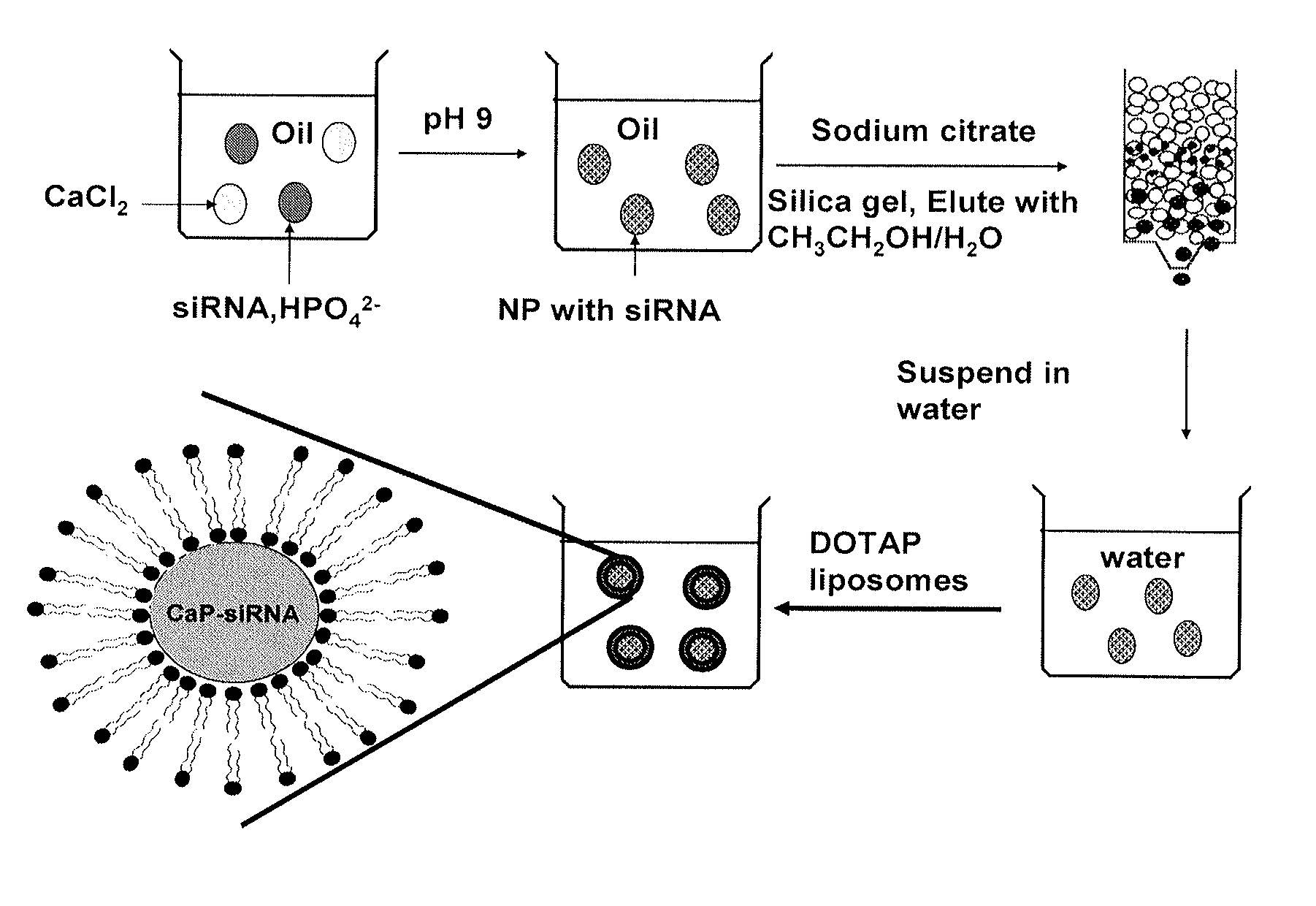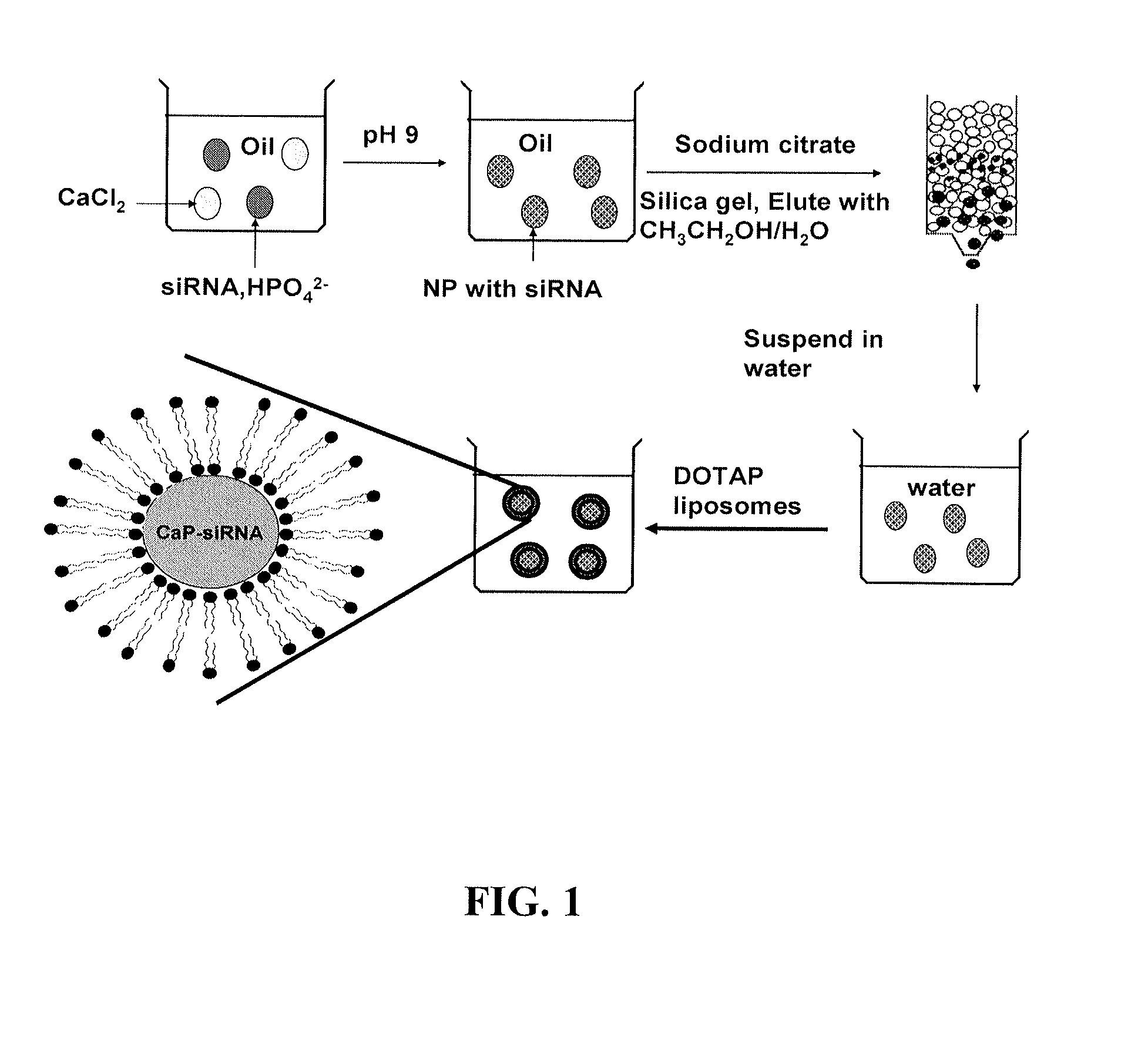Liposomes comprising a calcium phosphate-containing precipitate
a technology of calcium phosphate and liposome, which is applied in the direction of peptide/protein ingredients, packaged goods types, dna/rna fragmentation, etc., can solve the problems of toxic side effects and inability to efficiently release the incorporated bioactive compounds into the cytoplasm of cells, and achieve the effect of enhancing effectiveness and minimizing the toxicity of the delivery system complex
- Summary
- Abstract
- Description
- Claims
- Application Information
AI Technical Summary
Benefits of technology
Problems solved by technology
Method used
Image
Examples
example 1
Generation and Characterization of Lipid / Calcium Phosphate (LCP) Nanoparticles
[0345]Calcium phosphate (CaP) is frequently used as a non-viral vector for in vitro transfection of a wide variety of mammalian cells with little toxicity (Sokolova and Epple (2008) Angew Chem Int Ed Engl 47 (8):1382-1395). The delivery activity is probably related to the fact that CaP precipitates rapidly dissolve in acidic pH (Bisht et al. (2005) Int J Pharm 288 (1):157-168). An endocytosed CaP precipitate is believed to de-assemble in the endosomes and release its cargo into the cytoplasm. Previous attempts to improve the manufacture or efficiency of CaP precipitates have led to limited success (Olton et al. (2007) Biomaterials 28 (6):1267-1279). The studies presented herein describe the generation and characterization of lipid-coated calcium phosphate precipitates, which are referred to herein as liposome / calcium phosphate (LCP) nanoparticles. LCP nanoparticles are similar to the previously described l...
example 2
Materials and Methods for Example 2
[0377]The LCP-II nanoparticles were generated using the methods depicted in FIG. 10. Briefly, 250 mM calcium chloride and 250 mM sodium phosphate aqueous solutions were prepared separately. The pH of the calcium chloride solution was adjusted to a pH of about 7. The pH of the sodium phosphate solution was adjusted to a pH of about 9. The drug (e.g., siRNA, peptide, AraC monophosphate, gemcitabine monophosphate) was added to the calcium chloride solution. A first reverse water-in-oil microemulsion was created by adding 300 μL of the calcium chloride solution with the drug to 15 ml cyclohexane / triton-X100 / hexanol (78 / 11 / 11; v / v / v). A second reverse water-in-oil microemulsion was formed by adding 200 μL of the sodium phosphate solution and 200 μL 20 mM DOPA dissolved in chloroform to 15 ml cyclohexane / triton-X100 / hexanol (78 / 11 / 11; v / v / v). The two microemulsions were then mixed together. After about 30 min, 15 ml of ethanol (EtOH) was added and the so...
PUM
| Property | Measurement | Unit |
|---|---|---|
| mol % | aaaaa | aaaaa |
| diameter | aaaaa | aaaaa |
| diameter | aaaaa | aaaaa |
Abstract
Description
Claims
Application Information
 Login to View More
Login to View More - R&D
- Intellectual Property
- Life Sciences
- Materials
- Tech Scout
- Unparalleled Data Quality
- Higher Quality Content
- 60% Fewer Hallucinations
Browse by: Latest US Patents, China's latest patents, Technical Efficacy Thesaurus, Application Domain, Technology Topic, Popular Technical Reports.
© 2025 PatSnap. All rights reserved.Legal|Privacy policy|Modern Slavery Act Transparency Statement|Sitemap|About US| Contact US: help@patsnap.com



